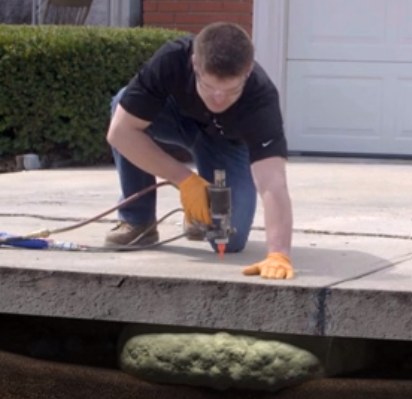How Poly-Level Can Lift and Repair Cracking Concrete
Concrete is a durable and versatile building material used in many applications, such as patios, driveways, garage floors, front porches, and back porches. However, concrete can develop cracks over time due to various factors, such as weather changes, soil settlement, and heavy loads. Cracks not only affect the appearance of concrete but also reduce its structural integrity and safety. In this blog post, we’ll explain the different signs to be aware of when concrete starts to crack and how Poly-Level can lift and repair it.
Signs of Cracking Concrete
Cracks in concrete can appear in different forms, sizes, and locations. Some cracks are cosmetic and not a significant concern, while others are structural and require immediate attention. Here are some signs of cracking concrete that you should be aware of:
- Hairline Cracks: Hairline cracks are small, shallow cracks that are less than 1/16 inch wide and don’t go all the way through the concrete. They are often cosmetic and don’t affect the performance of the concrete.
- Surface Cracks: Surface cracks are larger and deeper than hairline cracks, and they can be up to 1/4 inch wide. They are typically caused by freeze-thaw cycles, chemical exposure, or overloading. Surface cracks can allow water to penetrate the concrete and lead to further damage.
- Settlement Cracks: Settlement cracks are caused by the soil underneath the concrete settling or shifting. They can be diagonal or perpendicular to the surface and can extend through the entire thickness of the concrete. Settlement cracks can affect the structural integrity of the concrete and require immediate attention.
- Heaving Cracks: Heaving cracks are caused by soil expansion due to moisture changes, which can lift the concrete surface. They can be jagged or uneven and can create trip hazards. Heaving cracks can also affect the structural integrity of the concrete and require immediate attention.
Poly-Level: A Solution for Cracking Concrete
Poly-Level is a high-density polyurethane foam that is used to lift and level concrete slabs. It is a modern and cost-effective alternative to traditional concrete lifting methods, such as mud-jacking and slab replacement. Poly-Level is injected through small holes drilled in the concrete, and it expands to fill voids and lift the slab back to its original position. Here are some benefits of using Poly-Level to repair cracking concrete:
- Quick and Efficient: Poly-Level can be installed in a matter of hours, and the concrete can be used immediately after the installation. This means less downtime for your property and minimal disruption to your daily routine.
- Lightweight and Non-Invasive: Poly-Level is a lightweight material that doesn’t add significant weight to the soil or the concrete. It also doesn’t require heavy equipment or extensive excavation, which minimizes the damage to your property.
- Durable and Long-Lasting: Poly-Level is a waterproof and UV-resistant material that won’t shrink or deteriorate over time. It also provides a stable and solid base for the concrete, which reduces the risk of future settling and cracking.
- Environmentally Friendly: Poly-Level is made of recycled materials and doesn’t release harmful chemicals into the soil or the air. It is a sustainable and eco-friendly solution for concrete lifting and repair.
Conclusion
Cracking concrete can be a frustrating and costly problem for homeowners and business owners. However, with the help of Poly-Level, you can restore your concrete to its original level and strength without the need for extensive excavation or replacement. If you notice any signs of cracking concrete, such as hairline cracks, surface cracks, settlement cracks, or heaving cracks, don’t hesitate to contact The Foundation Specialists for a free inspection at 844.468.4674



